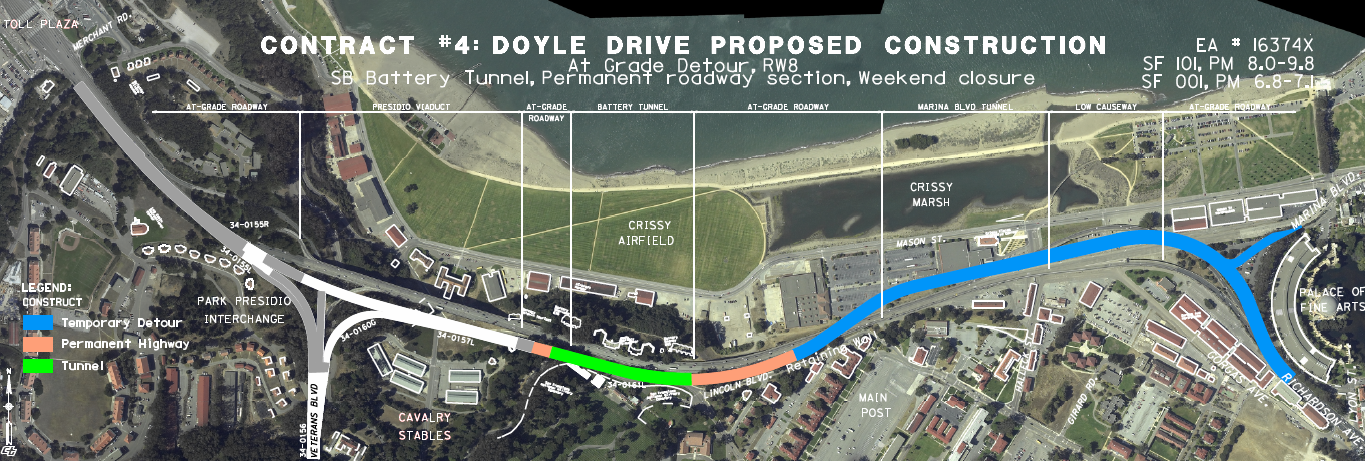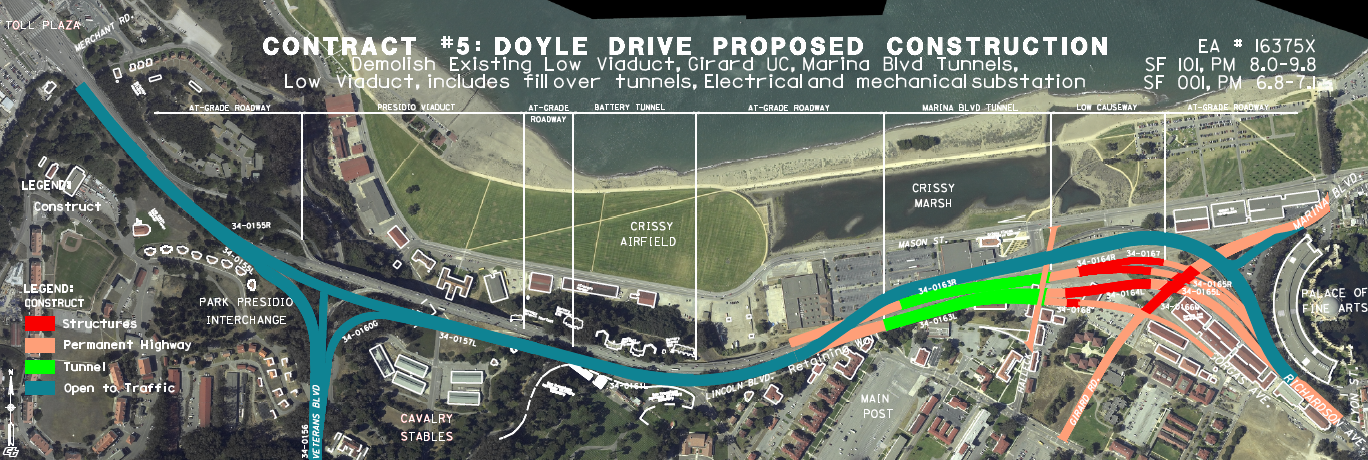New approach to Golden Gate Bridge accelerated
Apr 2009
Paula Wallis, Reporter
- Construction of the new 1.2-mile-long approach to the Golden Gate Bridge in San Francisco will begin this September - one year ahead of planned construction. The accelerated schedule of the Doyle Drive replacement project is the result of $100-million from the stimulus bill that closed the final funding gap.
-

Project area map
- Caltrans expects to advertise the first of three cut-and-cover tunneling contracts this summer with construction set to begin in the fall.
- At a news conference in February, House Speaker Nancy Pelosi said "Oh, what a happy day at long last.” The San Francisco Democrat says she is "a neighbor" of the project that has been in the planning stage for 15 years.
- With California’s unemployment rate above 10 percent – the highest in 26 years - Caltrans Director Will Kempton said moving into construction quickly will benefit commuters and create jobs in the construction industry that has been particularly hard hit by the recession.
-

Battery Tunnel design
- The entire project is expected to cost just over $1 billion. Roughly $90 million will be saved by the accelerated construction schedule.
- Several recognizable companies in the tunneling industry, including Balfour Beatty, Obayashi, Traylor Pacific, Kiewit Pacific, Jacobs, Parons, URS and Jacobs Associates attended a contractors outreach meeting for the project in early April.
- The project is broken into eight contracts with the tunneling components coming in contracts 4, 5 and 6. The new roadway consists of three lanes in each direction with a landscaped median from 16ft to 41ft wide (5m to 12.5m) plus a southbound auxiliary lane.
- A 1,476ft (450m) long viaduct varying from 66 to 115ft (20-35m) high will extend from the Park Presidio Interchange to the San Francisco National Cemetery where the lanes will descend into 787ft (240m) of shallow cut-and-cover Battery tunnels. The roadway will continue along a stetch of at-grade roadway, to the Main Post cut-and-cover tunnels that will run 984ft (310m). A final 525ft (160m) low causeway and an at-grade roadway completes the project. The amount of fill over the tunnels to provide for landscape plantings is expected to have a minimum depth of six feet (2m).
- Contract 3, which includes the southbound high viaduct, and Contract 4, that includes the first tunnel comment, will be awarded this summer.
- Contract 4 includes the 787ft southbound Battery tunnel, an at-grade temporary detour, a section of permanent roadway, and retaining walls (Fig 1).
- Contract 5, to be advertised in the summer or fall of 2010, includes the 984ft Main Post tunnels, demolition of the existing low viaduct, construction of the low causeway, the Girard undercrossing and retaining walls (Fig 2).
- Contract 6, which includes the northbound Battery Tunnel and at-grade roadway plus retaining walls, is scheduled for award in late 2010 or early 2011.
- Contract 7 and 8 will include the northbound high viaduct and landscaping for the entire project.
- Doyle Drive, or Route 101, serves as the south access to the Golden Gate Bridge. Winding 1.5 miles along the northern edge of San Francisco, the roadway is the primary highway and transit linkage through San Francisco, between counties to the south (San Mateo and Santa Clara) and to the north (Marin and Sonoma). The project area extends, on the west from the Golden Gate Bridge Toll Plaza to Broderick Street on the east, and includes Richardson Avenue, Gorgas Avenue and Marina Boulevard.
- Built in 1936, the roadway currently handles some 100,000 vehicles a day. Supporters point out that it lacks medians and shoulders, is constructed on unstable ground and would not survive a major earthquake.
- Funding sources for the Doyle Drive replacement incude $202 million in Federal funding, $420 million from the State and $333 million from local sources. The entire project is anticipated to be complete in 2012.



